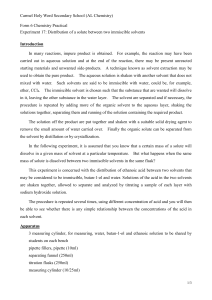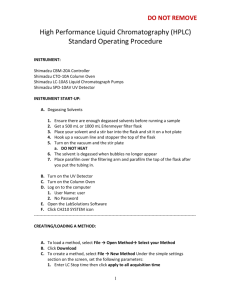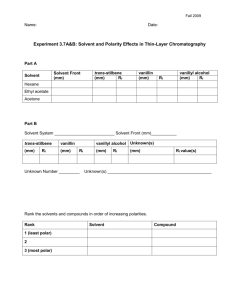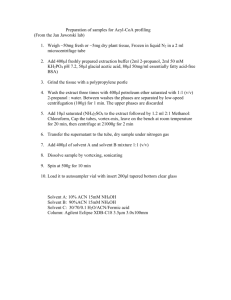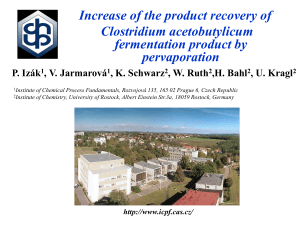EXPERIMENT 20
advertisement
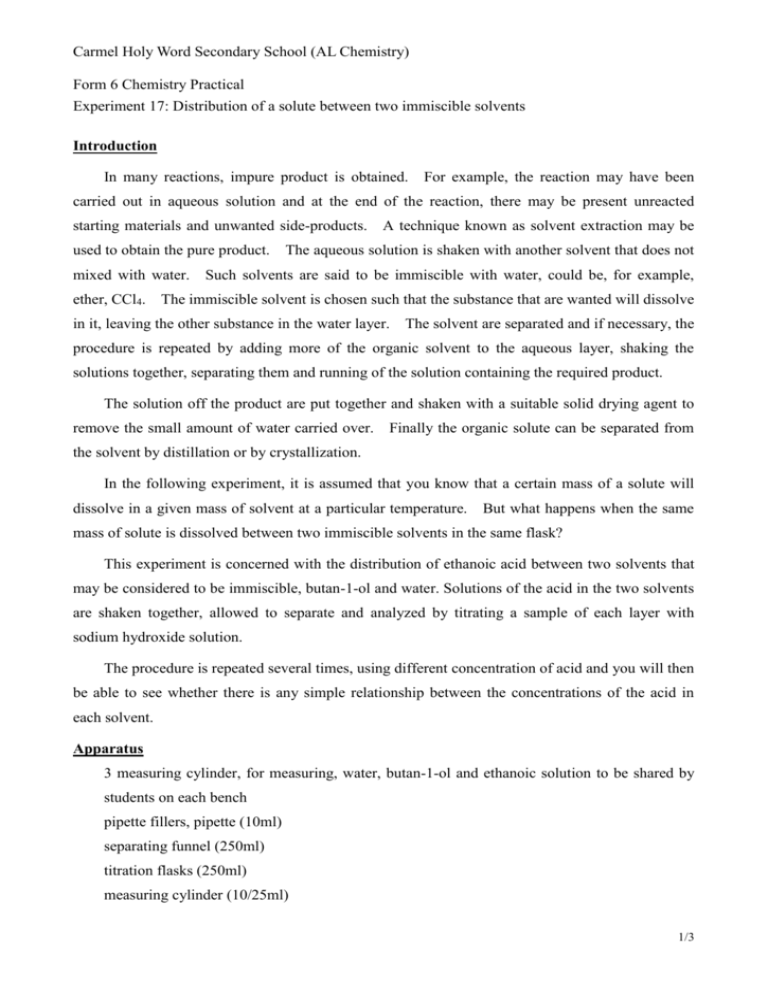
Carmel Holy Word Secondary School (AL Chemistry) Form 6 Chemistry Practical Experiment 17: Distribution of a solute between two immiscible solvents Introduction In many reactions, impure product is obtained. For example, the reaction may have been carried out in aqueous solution and at the end of the reaction, there may be present unreacted starting materials and unwanted side-products. used to obtain the pure product. mixed with water. A technique known as solvent extraction may be The aqueous solution is shaken with another solvent that does not Such solvents are said to be immiscible with water, could be, for example, ether, CCl4. The immiscible solvent is chosen such that the substance that are wanted will dissolve in it, leaving the other substance in the water layer. The solvent are separated and if necessary, the procedure is repeated by adding more of the organic solvent to the aqueous layer, shaking the solutions together, separating them and running of the solution containing the required product. The solution off the product are put together and shaken with a suitable solid drying agent to remove the small amount of water carried over. Finally the organic solute can be separated from the solvent by distillation or by crystallization. In the following experiment, it is assumed that you know that a certain mass of a solute will dissolve in a given mass of solvent at a particular temperature. But what happens when the same mass of solute is dissolved between two immiscible solvents in the same flask? This experiment is concerned with the distribution of ethanoic acid between two solvents that may be considered to be immiscible, butan-1-ol and water. Solutions of the acid in the two solvents are shaken together, allowed to separate and analyzed by titrating a sample of each layer with sodium hydroxide solution. The procedure is repeated several times, using different concentration of acid and you will then be able to see whether there is any simple relationship between the concentrations of the acid in each solvent. Apparatus 3 measuring cylinder, for measuring, water, butan-1-ol and ethanoic solution to be shared by students on each bench pipette fillers, pipette (10ml) separating funnel (250ml) titration flasks (250ml) measuring cylinder (10/25ml) 1/3 Carmel Holy Word Secondary School (AL Chemistry) Reagents Butan-1-ol 100ml per group 2M ethanoic acid 120ml 0.5M NaOH about 150ml phenolphthalein indicator Procedures 1. From the measuring cylinder, add 25cm3 of butan-1-ol, 10cm3 2M ethanoic acid and 40 cm3 water into the separating funnel. 2. Shake the mixture for about 5 minutes to allow ethanoic acid to dissolve in both layer. Keep your hand on the stopper and hold the tap with the other hand. Always keep the jet pointing upwards and away from every one. Open the tap to release the build-up pressure, approximately every 30 seconds. After shaking, rest the funnel on a clamp vertically and allow the layers to separate. This will take about 1 minute. 3. Using the pipette and pipette filler, transfer 10cm3 of the upper layer (butan-1-ol) into a conical flask. Using a measuring cylinder, add about 25cm3 of water to the flask, followed by 3 drops of phenolphthalein indicator. Titrate the resulting mixture against the standard NaOH solution. 4. Insert a second pipette, into the bottom layer (aqueous) through the top layer, squeeze the pipette filler bulb so that bubbles of air are expelled to ensure that no alcohol remains in the jet of the pipette before you withdraw 10cm3 of the aqueous layer into a titration flask. Titrate it against the standard NaOH solution as before. Wash the flask and funnel thoroughly with water and finally rinse with distilled water. Shake out as much water as you can before you start the next set of mixture. Repeat the experiments above with three other mixtures of butan-1-ol, water and ethanoic acid outline in the table.. Record your results into the table below. N.B. DO NOT POUR ORGANIC SOLVENTS DOWN THE SINK. POUR THEM INTO THE WASTE SOLVENT BOTTLE PROVIDED. 2/3 Carmel Holy Word Secondary School (AL Chemistry) Result Mixture Butan-1-ol / cm 3 Ethanoic acid / cm 3 Water / cm 1 25 10 40 2 25 25 25 3 25 35 15 4 25 50 0 Titre / cm3 3 Organic layer Aqueous layer Data Treatment 1. Construct a graph by plotting the volume of sodium hydroxide used to titrate the acid in the butan-1-ol layer against the volume used to titrate the acid in the water layer. 2. What is the quantitative significance of the slope of the graph you have obtained? 3. Why must the immiscible solution be separated before the ethanoic acid is titrated? 4. 0.2g of a substance X are dissolved in 100cm3 of a solvent B. As much of X as possible is to be extracted from solvent B to a second solvent A, which is immiscible with B. The partition coefficient between the two solvents is 4 at the temperature of the operation. Calculate whether it is more effective to shake the solution of X in B with 100cm3 of A or with two separate portions of 50cm3 of A. 3/3
